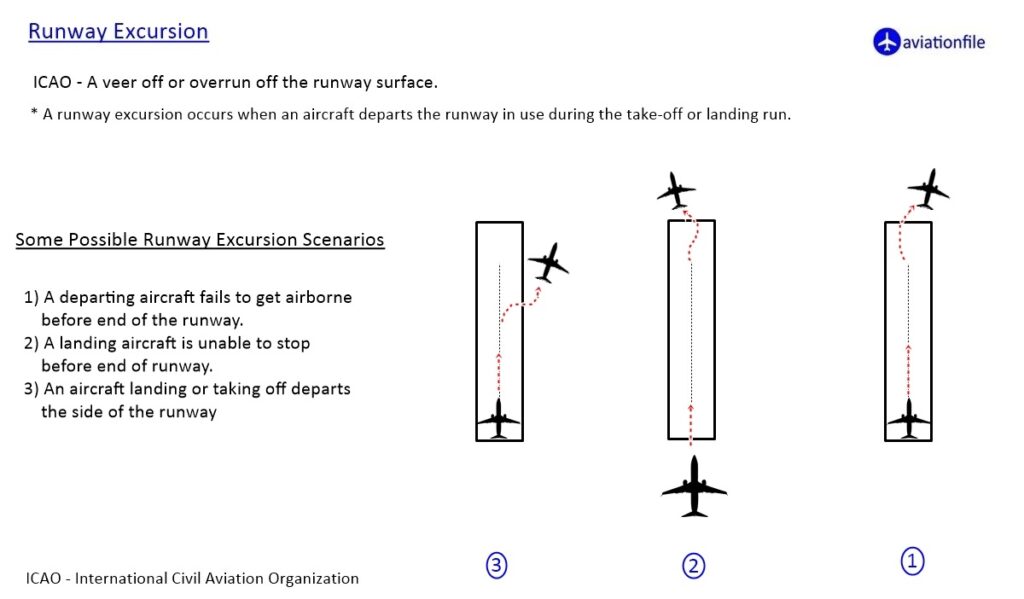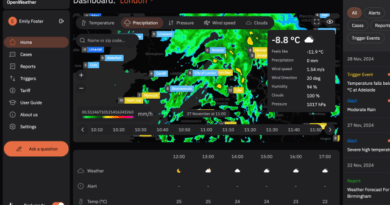Runway Excursion: Causes, Effects, Prevention, and Safety Measures
Runway excursions are critical aviation incidents where an aircraft veers off or overshoots the runway during takeoff or landing. These incidents are among the most common in aviation, responsible for approximately one-third of all aviation accidents globally (Flight Safety, ICAO).
Understanding Runway Excursions
Runway excursions are a major safety concern. Factors contributing to these incidents include pilot error, adverse weather, and mechanical failures. Given their frequency and potential severity, aviation authorities prioritize reducing runway excursions to improve overall safety.

Common Causes of Runway Excursions
- Pilot Error: Mistakes in judgment or procedure during takeoff or landing can lead to runway excursions. This may involve misjudging speed, altitude, or runway length.
- Adverse Weather: Poor weather conditions like rain, snow, or strong winds can make runways slippery or reduce visibility, significantly increasing the risk of an excursion.
- Mechanical Failures: Failures in braking systems, engines, or other critical components can prevent an aircraft from stopping within the runway’s limits.
- Runway Contamination: Ice, snow, or water on the runway can reduce friction, causing aircraft to skid and veer off the runway.
Possible Effects of Runway Excursions
- Injury or death of people on board,
- Damage to the aircraft,
- Damage to the aerodrome, equipment and etc.,
- Harmfull effect to the people, anything around the incident area,
- Heavy work load for professionals,
- Possible runway, airport closure,
- Delay and/or diversion for other traffics,
- Workload on ATM,
- Loss of revenue,
- Negative company image,
- Insurance issues.
It is possible to enlarge the list with more detailed effects. But this list is enough to ensure the importance of safety in aviation.
Preventive Measures
To mitigate the risk of runway excursions, several preventive strategies have been implemented:
- Enhanced Pilot Training: Pilots receive rigorous training to handle complex landing and takeoff scenarios, including simulations of various weather conditions and mechanical failures.
- Improved Weather Forecasting: Accurate and timely weather data assists pilots and air traffic controllers in making informed decisions, reducing the likelihood of runway excursions due to unexpected weather.
- Runway Maintenance: Regular maintenance ensures runways remain clear of contaminants like ice and debris, particularly during winter months.
- Runway Safety Areas: Many airports have expanded runway safety areas (RSAs) to provide extra space for aircraft to stop safely if they overshoot the runway.
- Advanced Aircraft Technology: Modern aircraft are equipped with systems such as automatic braking that help prevent runway excursions.
Importance of Adherence to Procedures
Strict adherence to standard operating procedures (SOPs) is crucial in preventing runway excursions. Pilots must follow prescribed procedures during takeoff and landing. Deviating from these procedures can significantly increase the risk of an excursion.
Some of the Remarkable Excursion Incidents Worldwide
Philippine Airlines Flight 137 – Bacolod City Domestic Airport / Philippines (1998)
(22 March 1998) Airbus A320-214, registration number RP-C3222 overshot the runway while landing at Bacolod City Domestic Airport. There were no fatalities among the aircraft’s crew and passengers, but three people died on the ground as the airliner plowed through a residential area. It was reported that human factors caused the incident (Incident report PDF click).
Air France Flight 358 – Toronto Pearson International Airport in Ontario / Canada (2nd of August 2005)
It was a regularly scheduled international flight from Charles de Gaulle Airport in Paris, France, to Toronto Pearson International Airport the Airbus A340 operating the route overran the runway and crashed into nearby Etobicoke Creek, approximately 300 m (980 ft) beyond the end of the runway. All 309 passengers and crew on board the Airbus survived, but twelve people sustained serious injuries. Because no deaths in the accident, press sources described the accident as miracle in Toronto.
Southwest Airlines Flight 1248 – Midway International Airport / Chicago, Illinois, U.S.A (8th of December 2005)
Southwest Airlines Flight 1248 was a scheduled passenger flight from Baltimore, Maryland, to Chicago, Illinois, to Salt Lake City, Utah, and then to Las Vegas, Nevada.
The Boeing 737-700 overran the runway while landing in a snowstorm and crashed into automobile traffic, killing one person (child) on the ground (Accident report PDF click).
S7 Airlines Flight 778 – Irkutsk International Airport / Russia (9th of July 2006)
It was a scheduled domestic passenger flight, flying from Moscow Domodedovo to Irkutsk The Airbus A310 registration F-OGYP, overshot the runway and struck a concrete barrier with high speed. The aircraft to break apart and igniting a massive fire. In the accident 125 of the 203 occupants were killed (Incident report PDF click).
Pegasus Airlines Flight 2193 – Sabiha Gökçen Int. Airport / Turkey (5th of February 2020)
It was a scheduled domestic passenger flight from Izmir to Istanbul in Turkey operated by Pegasus Airlines. The B737 – 800 with registration TCIZK, three people were killed, 179 people were injured, and the aircraft was destroyed. It was the first fatal accident in the airline’s history.
As you see there are various reasons and various accidents which are all unique to circumstances. So what can be done to reduce the amount of runway excursions or maybe reduce the risk of excursions. On that point Flight Safety Foundation published a “Reducing the Risk of Runway Excursions” report.
On the other hand, Airbus company developed and designed a “Runway Overrun Prevention System” (click for System Details – PDF) (ROPS) and tested at Rovaniemi Airport in Finland during the winter of 2016. The system is certified by EASA for A330 family.
Conclusion
Runway excursions are preventable with the right training, technology, and adherence to safety procedures. As the aviation industry continues to evolve, improving runway safety remains a top priority. By understanding the causes and implementing preventive measures, the industry can reduce these incidents and enhance overall safety.


